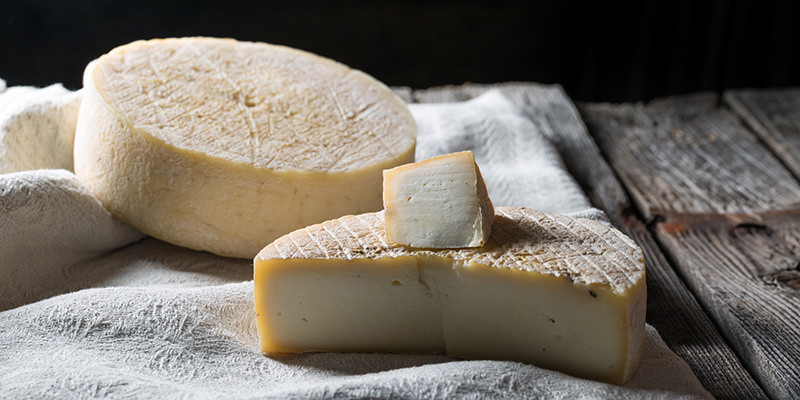Of all the delights in the wide world of artisanal cheese, goat cheese is perhaps the most versatile for two reasons: one, it comes in an array of styles and flavors, and two, it is suitable for the lactose-intolerant. While France is known to be the home of some of the world’s most interesting goat’s milk cheeses, there is a burgeoning domestic scene here in the U.S. that’s devoted to producing the finest artisanal goat’s cheese.
Almost one year ago, I started teaching wine and cheese pairing classes at Murray’s Cheese in Manhattan, and I’ve learned a lot by working with the “curd nerds” on staff there. To get some extra knowledge, I asked a few cheesemakers and one top sommelier to share their approach to enjoying cheese with wine, plus I tasted many delicious goat cheeses and played around with some different pairings. The result: these unique tips for enjoying goat cheese, and pairing it with just the right beverage—whether wine, cider, beer, or spirits.
First, a fun fact:
Did you ever notice that goat’s cheese is white, unlike cow’s cheese, which is yellow? That’s because goats live in rocky environments, and they are very clumsy, so their bodies have evolved over time to process the Vitamin A they consume from eating grass. They convert it into beta carotene to fortify their bones and protect them from all those tumbles. Cows, on the other hand, just let the Vitamin A come out through their milk. Just a little tidbit to share at a cocktail party, while you’re nibbling!
Lauren Gitlin, assistant cheesemaker at Twig Farm in Vermont, explained that goat’s milk, unlike other milks used for cheesemaking, is “higher in acidity and has a trademark goaty-ness,” which are both more pronounced in fresh cheeses, like those chèvre logs you find at your local supermarket.
It’s not just what’s inside that counts: Rinds are extra important for goat’s cheese.
A common question about aged artisanal cheese is, “Can I eat the rind?” With the exception of wax-rind Gouda-style cheeses, you can and even should eat the rinds. They are full of tummy-friendly bacteria (a fungus called Geotrichum candidum is what creates that wrinkly, brainy-looking mold on many cheeses), and more importantly, the rind is actually part of the cheese’s flavor profile. Try a part of the cheese without the rind, then try it with, to compare.
That “ash rind” that Allison Hooper mentioned above? You may have seen it at your local cheesemonger: wrinkly, brainy, gray—quite unusual looking. So, here’s the deal: a long time ago, in that famed Loire Valley region, cheesemakers figured out that by rolling their goat cheeses in a pile of ashes—often made from burning grape vines—they could not only preserve the cheese better, but it also improved the ripening process and made an overall more complexly flavored cheese.
Today, food grade ash is used to make these kinds of cheeses, so don’t worry—you’re not consuming dirty cheese! Ash rind goat’s cheeses can be incredibly complex, and often quite tangy.
Scotch. With goat’s cheese. Totally works.
Vermont Creamery makes an awesome, tiny cheese called the Bijou (which means “jewel” in French), and is dense, with a Geotrichum rind. It’s made in the style of Crottin de Chavignol, a Loire Valley cheese that comes in a small cylindrical shape.
I tried it with Scotch, and it was perfect. I opted for a blended Scotch, since blended Scotch is typically more affordable than single malts, from Black Grouse, which is not too peaty but has just enough smokiness to compliment the cheese’s chalky texture and its wrinkled, nutty rind. Delicious.
Belgian style beers, especially the wild fermented Lambic ones, are also amazing with tart and chalky goat cheese.
Say “Oui” To Loire Valley Wines:

Pairing based on terroir is simple: what goes together, grows together. France’s Loire Valley, in the Northwest of the country, is considered the home of many of the most popular styles of goat’s cheese. So, when you’re looking for a wine to pair with that cheese plate, wines of the Loire Valley are a no-brainer.
Sancerre, a Sauvignon Blanc-based wine from the Loire Valley, pairs very well with fresher styles of goat’s cheese. They have acidity, so one doesn’t overpower the other,” says Allison Hooper, founder of Vermont Creamery, which makes Loire Valley-style goat cheeses. If you prefer red wine, Hooper recommends the Loire Valley varietal Cabernet Franc, which, she says, “is better with an ash rind [more on this below] that’s more complex and aged. As the cheese gets older and it breaks down, it will get softer under the rind.”
Rosé is your friend if the cheese is fresh.
I’m a big advocate for drinking rosé year-round, and the cheese plate is the perfect scenario for doing this. You can really drink any kind of rosé you like, but I think a nice clean, crisp, Provencal style rosé—the really pale kind, such as from Bandol—is a show-stopper when paired with bright goat’s cheese.
If you’re doing a salad with fresh goat’s cheese, like the kind that comes in a log, then a pale, crisp rosé is a brilliant pairing. Here’s my recipe for a really simple salad featuring fresh chèvre. It goes wonderfully with Provencal style rosé:
Assemble the following ingredients in a bowl:
- Mesclun greens
- Goat’s cheese, sliced from the log using unflavored dental floss
- Dried cranberries or golden raisins
- Chopped and toasted almonds
Instructions: Mix high-quality balsamic vinegar, extra virgin olive oil, sea salt and freshly ground black pepper, and toss with the above.
Beyond acid-driven wines, just go completely crazy.
Lauren Gitlin gushes about her favorite young goat’s milk cheeses, called Le Pyramid from Lazy Lady Farm in Vermont. “It’s a gorgeous cheese made in the style of the French Poulingy St. Pierre, and it has that amazing, floral geotrichum rind.” But she advises steering clear of “intensely acid driven wines” because the cheese already has so much “bright, lemony acidity.”
Instead, she suggests looking for a riper, rounder white wine—could be a Chenin Blanc, or perhaps something a bit sweet like an off-dry Riesling. Or, try a cider from Vermont for a terroir pairing. Shacksbury, an artisanal cidery in Vermont, makes a delicious, fresh cider that comes in a beautiful bottle, and is perfect with high-acid cheese. They even have a new sparkling cider out, which would be amazing with any high-fat (double-crème) cheeses. There are also some delicious ice ciders coming out of Vermont that are sweet but not too viscous, and would be a special treat alongside chalky, aged goat cheese.
Feeling fancy? Take some expert tips from a knowledgeable sommelier.
Caleb Ganzer, head sommelier at the Manhattan wine bar Compagnie de Vins Surnaturels, shared his preferred pairing for their goat cheese, a Loire Valley ash-rind delight called Chèvre du Colline. It’s a fairly young cheese that’s mild rather than tangy, and has a creamy texture as well as a beautiful chalkiness. Ganzer likes two styles of wine with this cheese: one is a Blanc de Blancs Champagne and the other is a Sancerre rouge (yes, they do make red wine in Sancerre, with Pinot Noir).
The Blanc de Blancs, being made from all Chardonnay, is “quite assertive and lean in its approach, with a similar chalky quality that teams up quite well with the texture of the cheese, and a bright acidity which marries well with the slight tang of the goat,” says Ganzer.
Ganzer’s describes the Sancerre Rouge as having “tart, yet dark red and black fruit flavors,” which “provide a nice contrast for the core flavor of the cheese, while the supple nature of the wine embraces the chalky texture of this particular chèvre.”
Lastly: all artisanal cheese should be served at room temperature, to get the most flavor. Enjoy!

